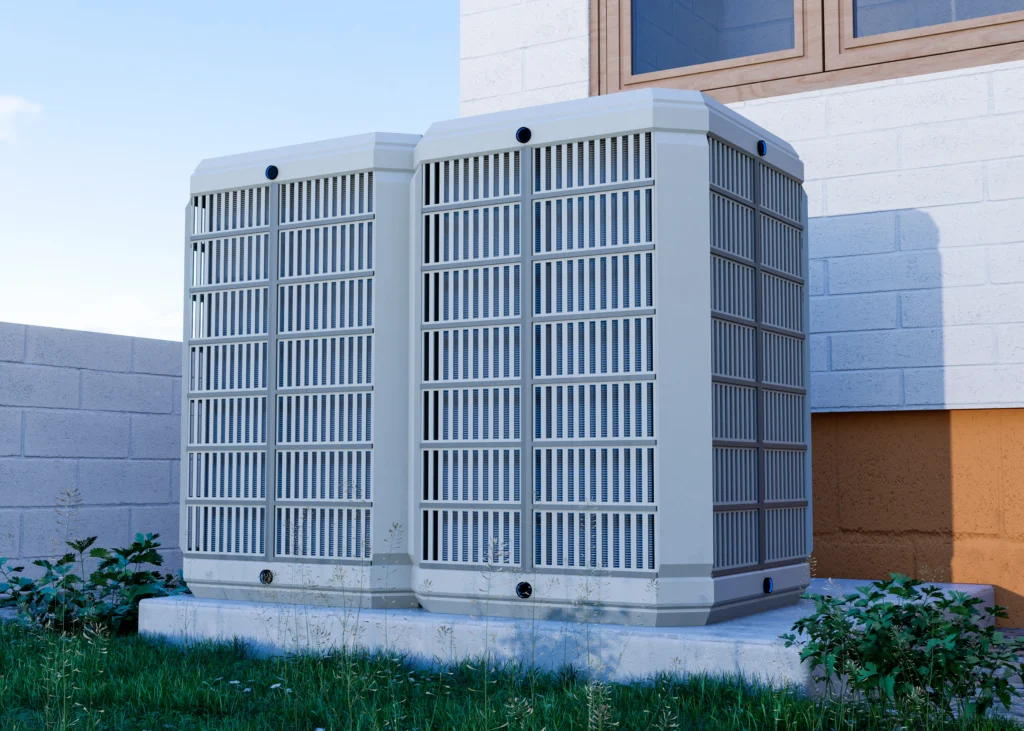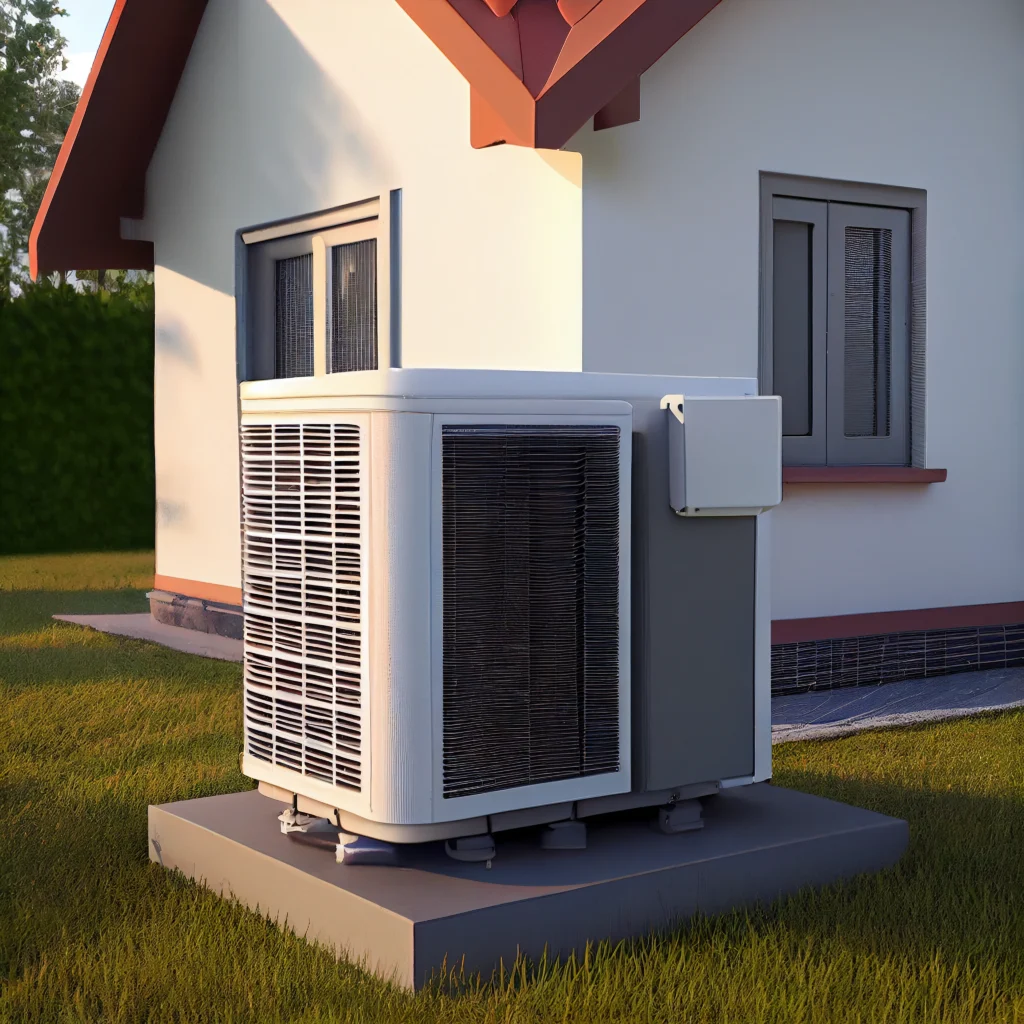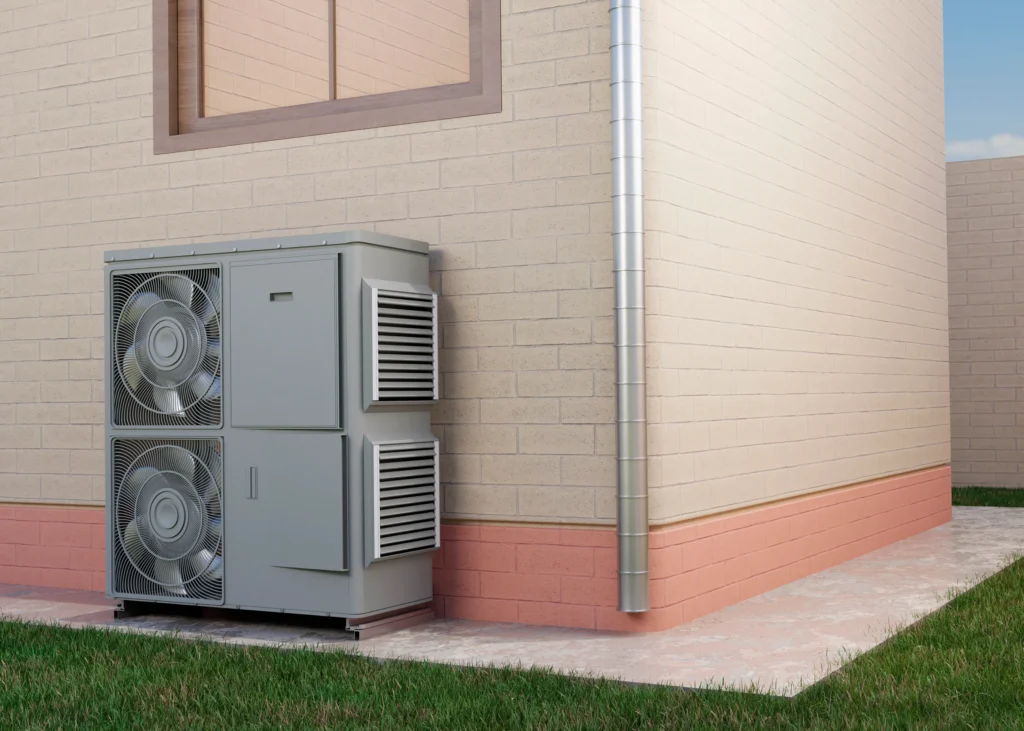Meet your new cooling sidekick – the ductless mini split AC system. Ready to dive into the world of innovative features? Get set for a game-changer! From personalized comfort to energy savings, this guide unveils the cutting-edge tech transforming how we chill. Let’s make your home the smartest (and most excellent) spot on the block!
What Is A Mini-Split?
Exploring climate control details, the ductless mini split AC system stands out as a captivating innovation. Unlike traditional HVAC systems, it doesn’t bother with bulky ductwork, changing how we handle indoor temperatures.
With an indoor unit and an outdoor condenser connected by a conduit carrying refrigerant lines and power cables, the mini-split becomes your personalized climate maestro. Its compact design and effective heat exchange make it a flexible solution for heating and cooling needs.
Understanding The Dynamics
The indoor unit of the mini-split sucks in heat from the room, and the outdoor condenser kicks it out. The refrigerant flow makes This tag team possible, making the mini-split your go-to comfort buddy all year long. No ducts mean easier installation and better temperature control, reducing wasted energy.
What Is A Ductless Air Conditioner?

Let’s dissect the intricacies of ductless air conditioners (ACs), a subset of the mini-split family. These systems go beyond the conventional cooling role, offering heating and cooling functionalities without requiring ductwork. Picture a home where the limitations of traditional central air systems do not bind climate control.
Breaking Down The Components
A ductless AC system comprises indoor units linked to an outdoor condenser through a conduit, forming a smooth connection that enables zoned control. Each room or zone can be managed separately, offering personalized comfort based on individual preferences. Without ducts, not only does it boost energy efficiency, but it also promotes a cleaner and healthier indoor environment.
The Versatility Of Ductless ACs
Ductless ACs come in various configurations, accommodating both single-zone and multi-zone setups. A single-zone system focuses on cooling or heating a specific area, making it ideal for smaller spaces like bedrooms or home offices. On the other hand, multi-zone systems cater to larger homes, offering independent control over multiple zones. This adaptability makes ductless ACs a versatile solution for diverse living spaces.
Operation Beyond Boundaries
The operational principle of ductless ACs aligns with their mini-split counterparts. Efficient heat exchange, facilitated by refrigerant circulation, ensures optimal temperature regulation.
This flexibility, combined with the absence of ducts, positions ductless ACs as the frontrunners in modern climate control technology. In our next segment, we’ll delve deeper into the workings of ductless mini split AC systems, unraveling the intricacies that make them indispensable in home comfort.
How Ductless Mini Split AC Systems Work

Diving into how ductless mini split AC systems work reveals the fascinating mechanisms that make them stand out in home climate control.
They operate on a fundamental principle of heat exchange, creating a seamless dance between the indoor unit and the outdoor condenser.
The Dance Of Heat Exchange
In a ductless mini-split, the indoor unit does a nifty job of soaking up heat from the room, kicking off an excellent process.
This heat gets a ride through refrigerant lines to the outdoor condenser, where it gets set free into the air. This non-stop loop ensures you stay cool in hot weather and warm in the chilly months. The secret sauce? The smooth refrigerant flow turns into a versatile all-year-round comfort solution.
Liberating Spaces from Ducts
Ductless mini split AC systems stand out for their freedom from traditional ductwork. Without ducts, these systems provide precise control over individual zones, cutting down on energy waste and ensuring peak comfort where it’s needed most.
No ducts mean easier installation and fewer problems like leaks and uneven airflow, often seen with central air systems.
Mini-Splits vs. Central Air
In the clash between mini-splits and central air systems, each contender brings unique strengths and weaknesses to the arena.
Central Air, a long-standing champion in home cooling, relies on extensive ductwork to distribute air throughout the house.
The Central Air Conundrum
Central air systems provide whole-house cooling, but they have some drawbacks. Everyday efficiency issues include leaky ducts, uneven airflow, and energy loss during distribution. Also, the one-size-fits-all cooling approach may not suit individual preferences, causing discomfort in specific areas of the house.
The Ductless Mini-Split Advantage

Meet the agile contender – the ductless mini-split. Say goodbye to ducts and hello to precise control over individual zones. No more inefficiencies linked with central air. You can regulate each room or zone independently, ensuring top-notch comfort without sacrificing energy efficiency. This adaptability is especially useful in homes where people have different temperature preferences.
The Zoning Revolution
Zoning is a game-changer with ductless mini-splits. Instead of treating your entire home as one unit, these systems divide it into specific zones, each with its thermostat for personalized control.
This saves energy and tackles the challenge of keeping a consistent temperature throughout the house.
In the next section, we’ll dive deeper into the concept of zones, differentiating between single-zone and multi-zone systems in the world of ductless mini-split ACs.
What Is Mini Split AC’s Zone? Single- And Multi-Zone Systems
Unlocking the full power of mini-split AC systems depends on grasping the idea of zones.
These systems transform climate control by dividing spaces into zones, making it possible to adjust temperatures as needed.
Let’s explore single-zone and multi-zone systems to understand how they work and their benefits.
Single-Zone
A single-zone mini-split AC system focuses its cooling and heating power on one area or room in a home.
It’s perfect for smaller spaces like bedrooms, home offices, or additions, where personalized temperature control matters most.
Imagine being able to adjust the climate in your bedroom without affecting the temperature throughout the house.
Precision in Personalized Comfort
The single-zone setup gives you exact control over a specific area. The indoor unit in that zone becomes the main focus, making climate management efficient and personalized.
This boosts comfort and saves energy by avoiding unnecessary cooling or heating in unoccupied spaces.
Multi-Zone
On the other hand, a multi-zone mini-split AC system covers multiple areas or rooms in a home.
It accommodates different temperature preferences by allowing independent control over each zone.
This incredibly adaptable setup guarantees every family member can have their desired climate without compromise.
The Flexibility Of Choice
Multi-zone systems have several indoor units linked to a central outdoor condenser.
This setup efficiently handles the cooling and heating requirements of different zones simultaneously.
The flexibility of a multi-zone configuration makes it an excellent option for larger homes, prioritizing personalized comfort across various living spaces.
Harmonizing Independence
Multi-zone systems offer a unique advantage in promoting individual control.
Each zone operates independently, enabling occupants to set their preferred temperature without impacting other house areas.
This resolves temperature disagreements within the family and optimizes energy usage by concentrating on occupied zones.
Choosing Between Single-Zone And Multi-Zone

Choosing between a single-zone and multi-zone mini-split AC system depends on your home’s layout and needs.
A single-zone system might be enough for smaller spaces or areas with minimal cooling or heating needs.
However, a multi-zone system provides a customized and efficient solution in larger homes with varying temperature preferences and different living areas.
As we delve deeper into ductless mini split AC systems, we’ll shift our attention to their overall features, advantages, and potential drawbacks.
Stay tuned to discover the details that make these systems essential for modern home comfort.
Ductless Mini-Split Air Conditioners
Discovering ductless mini-split air conditioners opens up a new way to think about keeping our homes comfortable.
These systems are known for being efficient and versatile, bringing a range of benefits to enhance the coziness of our living spaces.
Let’s delve into the unique features that make ductless mini-split air conditioners a key player in today’s HVAC technology.
What Is Ductless AC’s Benefit?
Ductless air conditioners, also known as ductless mini-splits, bring many advantages.
From minimal installation hassles to precise climate control, these systems have revolutionized how we think about cooling and heating our homes.
Minimal Installation With Ductless
One of the primary benefits of ductless mini-split air conditioners is their streamlined installation process. Unlike traditional HVAC systems that require intricate ductwork, ductless systems eliminate this complexity. The absence of ducts reduces installation time and minimizes the disruption to your living space. It’s fresh air for those seeking a quick, hassle-free cooling or heating solution.
Efficient Heating And Cooling
Ductless mini-splits shine in energy efficiency, offering a budget-friendly option compared to traditional HVAC systems. Their zoned control prevents wasting energy on unoccupied areas, directing it exactly where it’s needed. This efficiency results in lower utility bills, making ductless mini-splits both sustainable and economical.
Precise Heating And Cooling
Ductless mini-split air conditioners excel in precision. With separate indoor units for different zones, people can adjust the temperature in each area to their liking.
This control boosts comfort and removes the need for compromises in bigger households with different temperature preferences.
Quiet Operation
Bid farewell to the intrusive hum of traditional HVAC systems. Ductless mini-splits operate with whisper-quiet efficiency, ensuring your indoor environment remains serene and undisturbed. This feature is particularly appreciated in bedrooms, offices, or any space where peace is cherished.
Allergy Control
For individuals sensitive to allergens, ductless mini-split air conditioners offer a welcome solution. Traditional HVAC systems with ducts can accumulate dust, mold, and allergens, contributing to poor indoor air quality.
Ductless systems mitigate this concern by eliminating the ductwork and providing cleaner and healthier air. Say goodbye to sneezing fits and allergy discomfort.
In the upcoming sections, we’ll closely examine the potential drawbacks and considerations linked to ductless mini split AC systems. This will provide a thorough understanding of their suitability for different home environments.
The Cons Of Ductless Mini Split AC System
While ductless mini split AC systems are celebrated for their efficiency and comfort, examining their potential drawbacks is essential. Let’s delve into the cons, highlighting factors that could affect homeowners’ decision-making process.
Cost
Indeed, the initial cost is one of the main worries with ductless mini split AC systems. Although they save money on energy bills in the long run, the upfront investment might be more than traditional HVAC options.
Homeowners must consider whether the upfront cost is worth compared to the potential benefits and energy savings over time.
Appearance
The appearance of indoor units can be a subjective matter. Some homeowners may find the sleek and modern designs of ductless mini split system units appealing, seamlessly blending with interior decor.
However, others may consider them less aesthetically pleasing compared to traditional vents.
Modern designs aim to minimize the visual impact, but personal preferences play a role in this consideration.
Need More Space to Install
Each indoor unit of a ductless mini split AC system requires wall space for installation. This can pose a challenge in smaller homes or rooms with limited wall space.
Strategic planning is essential to ensure optimal placement without sacrificing functionality or aesthetics.
Maintenance
Ductless mini split AC systems typically need less maintenance than traditional HVAC systems but still require some attention.
It’s essential to clean the filters regularly and schedule occasional professional check-ups to keep them running smoothly.
Homeowners should consider the maintenance time and effort when deciding on these systems.
Low Performance In Extreme Temperatures
Ductless systems may experience reduced efficiency in extreme cold or hot climates.
While advancements in technology are addressing this limitation, it’s crucial to assess the system’s performance against the specific climate conditions of the installation location.
Higher Installation Cost
The easy installation of ductless mini split AC systems can be a plus, but it might mean a higher initial expense.
This is particularly noticeable if substantial modifications, like electrical work or adjustments to fit the system, are required.
Homeowners must get detailed quotes and weigh the installation cost before choosing a ductless mini split system.
Next, we’ll tackle common questions and concerns about ductless air conditioners’ installation, cost, and efficiency.
This will offer helpful information for anyone considering this modern HVAC solution.
FAQ More About Ductless Mini Split AC Systems
How Much Does It Cost To Have A Ductless Air Conditioner Installed?
The installation cost of a ductless air conditioner can vary depending on factors such as the number of indoor units, the complexity of the installation, and the specific brand or model. On average, homeowners can expect to invest between $2,000 and $7,500 for installation.
How Much Does a Ductless Air Conditioner Cost?
The cost of a ductless air conditioner itself ranges from $1,500 to $4,000 per indoor unit. Additional costs may include installation, electrical work, and any necessary modifications to accommodate the system.
How Many BTU Ductless Air Conditioners Do I Need?
Determining the appropriate BTU (British Thermal Units) for a ductless air conditioner depends on factors such as the size of the room, insulation, and local climate. As a general guide, 12,000 BTUs typically cool a room of 400-600 square feet.
What Is Ductless ACS?
Ductless ACS, short for Air Conditioning Systems, is an HVAC system that cools and heats without using regular ducts. They include indoor units linked to an outdoor condenser via a conduit, allowing for efficient control of different zones for climate management.
How Much Voltage Does A Ductless Air Conditioner Need?
Many ductless air conditioners run on either 120 or 240 volts, depending on their model and capacity. To ensure safe installation, always refer to the manufacturer’s specifications and enlist the expertise of a professional electrician.
Are Ductless AC Units Energy Efficient?
Ductless AC units are renowned for their energy efficiency. By providing zoned control and avoiding energy loss through ducts, these systems can result in significant energy savings compared to traditional HVAC systems. Look for units with high SEER (Seasonal Energy Efficiency Ratio) ratings for optimal efficiency.
Conclusion
In-home comfort, ductless mini split AC systems are intelligent and efficient options. Their sleek designs and precise temperature control transform how we heat and cool our homes. While they have advantages and disadvantages, their ease of installation, energy efficiency, and ability to customize comfort make them an excellent choice for today’s homeowners. As technology advances, these systems will become easier to use and fit into any home, guaranteeing comfort throughout the year.
